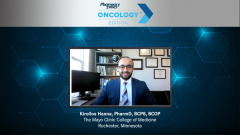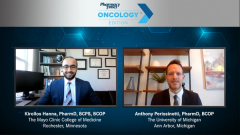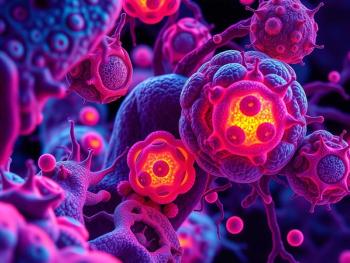
Noncovalent Binding BTK Inhibitors for Chronic Lymphocytic Leukemia
Dr Anthony Perissinotti details an effective new therapy on the horizon in chronic lymphocytic leukemia.
Episodes in this series

Kirollos Hanna, PharmD, BCPS, BCOP: An exciting concept in CLL [chronic lymphocytic leukemia] are noncovalent binding BTK [Bruton tyrosine kinase] inhibitors. We’re all ready, I think, blowing everybody’s mind with all the data in terms of BTK inhibitors, but we’re going to add even more BTK inhibitors. But what benefit do these noncovalent binding BTK inhibitors have? I know there are some mutations there that these could potentially benefit from. What did we see at ASH [American Society of Hematology 2021 Annual Meeting] about these therapeutics?
Anthony Perissinotti, PharmD, BCOP: I think the most exciting right now is pirtobrutinib. As you said, they’re noncovalent binding. They’re irreversible binding. But, honestly, I don’t know pharmacologically that that is really what matters. I think the most important things about pirtobrutinib are, number 1, it’s more selective to BTK, even more selective than an acalabrutinib [Calquence] and zanubrutinib [Brukinsa]. So much more selective. And number 2, the half-life. Ibrutinib [Imbruvica], acala [acalabrutinib], and zan [zanubrutinib] have a very short half-life; they have to covalently bind to BTK, and they just need to shut down BTK until you produce more BTK. But pirtobrutinib, being a reversible BTK inhibitor, needs a long half-life so that you’re constantly binding BTK. And then if you create more BTK, or there’s high cellular turnover, it’s still going to be around and it’s going to bind to BTK. Those are the 2 claims to fame of pirtobrutinib: selectivity and longer half-life. So how do I treat a patient who’s double exposed? So it's a clinical trial—a clinical trial with something like pirtobrutinib. Now, if I don’t have a clinical trial, what am I doing? I’m really thinking long and hard about what their previous therapy was and why they came off therapy. Was it for progression? For example, did the patient actually progress on venetoclax [Venclexta]? Did they not get a durable remission? If the answer to that is no, and yes, they had a durable remission, I would retreat them with venetoclax. Or, if you have a patient that just didn’t tolerate their BTK inhibitor, I would switch around their other BTK inhibitor and not necessarily move on to the next line of therapy. But, if it was truly a patient that progressed, and was completely intolerant to all BTK inhibitors, clinical trials is where I would go, and pirtobrutinib has some excellent data that was presented at ASH. So this is the BRUIN study. The BRUIN study had multiple different arms. They had a CLL and a mantle cell [lymphoma] arm. I’ll focus on the CLL arm. This is a phase 1/2 study in patients that have relapsed/refractory CLL. All patients received a BTK inhibitor, and many patients were refractory also to both BTK inhibitor and venetoclax. There was about 170 patients in this study. And despite being that refractory, about 63% of patients had an overall response. If you follow patients longer, we know from BTK inhibitors that responses do take some time. In patients that had at least 10 months of follow-up, that overall response rate moved from 63% up to 86%. So this is a very, very effective therapy that I think is going to hopefully get FDA [Food and Drug Administration]-approved in the next year or so, so that our patients who are double-exposed in double-refractory have an additional option so that they’re not having to use chemotherapy, and they’re not having to use PI3K [phosphoinositide 3-kinase] inhibitors like idelalisib [Zydelig]. Because, as you mentioned, the toxicities are not that great. But Dr Hanna, there is a nice new PI3K inhibitor, umbralisib, that was presented at ASH. Talk about that agent, how it’s different than our other PI3K inhibitors. You kind of ragged on the toxicity. Do we see that also with this new therapy?
Kirollos Hanna, PharmD, BCPS, BCOP: Dr Perissinotti, we have a novel PI3K inhibitor that is already FDA-approved in other B-cell malignancies. But umbralisib, there was actually some phase 2 data, really exciting in the CLL population; really interesting approach, too, not just looking at umbralisib, but they call it the U2 combination, but really focusing on umbralisib and how it’s distinguished from other PI3K inhibitors like idelalisib or duvelisib [Copiktra]. Its claim to fame is that it’s more selective, thus leading to off-target, again, kinase activity, potentially leading to a safer AE [adverse event] profile. So this is very selective to PI3K and casein kinase 1-epsilon as well. Again, more targeted, just really trying to focus on those fewer side effects, but really looking at the phase 2 data, looking at umbralisib in this patient population. What they wanted to do in this phase 2 trial—again, it was a small subset of patients, it was 26 patients that were recruited in this phase 2 trial, just really beginning to evaluate some efficacy signals—is that they treated patients with CLL with ibrutinib. For patients that did not achieve MRD [minimal residual disease] negativity, which again, in BTK monotherapy treatment, you don’t get a lot of MRD negativity, as all of us pretty much know. But what they did in this clinical trial is that they had this lead-in approach. And what they did in this patient population is that they added umbralisib, as well as ublituximab, and that’s why it’s called U2. Both begin with a U. And ultimately, what ublituximab is, it’s a novel anti-CD20 monoclonal antibody. It is glycoengineered for enhanced antibody-dependent cellular cytotoxicity, so really trying to—the goal here was to induce undetectable MRD, minimize the potential risk of developing BTKi [Bruton tyrosine kinase inhibitor] resistance or mutations, and maybe even stopping all the CLL-directed therapies and to see what type of durable response. This is a very, very early study with a very small subset of patients. But what they noticed in this clinical trial is, again, in CLL, this is the first MRD-driven approach, not so much of treating patients and then evaluating what their MRD outcomes were, but it was more of treating patients, looking at MRD, and then changing therapy based on MRD. It was really interesting to see that. And what they saw was promising; tolerability and efficacy signals, whereas that undetectable MRD negativity was achieved in 71% of patients that got that addition of U2 to ibrutinib. So pretty exciting. But I would take it as a small subset of patients. Again, we don’t really know the full extent of MRD negativity and what that means in terms of outcomes, so it’s going to be exciting to see what will come from this.
Transcript edited for clarity.
Newsletter
Stay informed on drug updates, treatment guidelines, and pharmacy practice trends—subscribe to Pharmacy Times for weekly clinical insights.
















































































































































































































